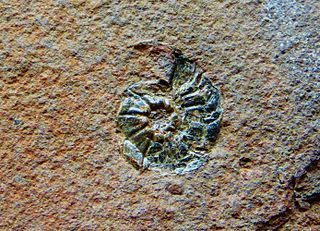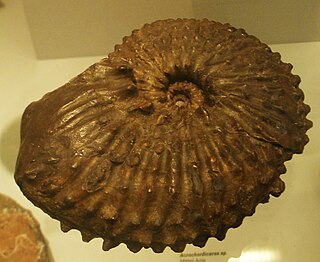
The Nautilida constitute a large and diverse order of generally coiled nautiloid cephalopods that began in the mid Paleozoic and continues to the present with a single family, the Nautilidae which includes two genera, Nautilus and Allonautilus, with six species. All told, between 22 and 34 families and 165 to 184 genera have been recognised, making this the largest order of the subclass Nautiloidea.
Abichites is ceratitid genus, assigned to the family Dzhulfitidae, from the Upper Permian of Armenia, Azerbaijan, and Iran, with three species recognized: A. abichi, A. mojsisovicsi, and A. stoyanowi.
Xiphogymnites is an extinct ammonoid cephalopod genus from the Triassic included in the family Gymnitidae. It is known from the Balkans in eastern Europe.

Asklepioceras is a genus in the Ceratitid family Arpaditidae from the Middle and Upper Triassic of Italy, Romania, Turkey, and British Columbia (Canada).
Anderssonoceras is a genus of small, smooth ammonites with a flared umbilical shoulder, like Prototoceras, assigned to the ceratitid family Anderssonoceratidae as the type, but once included in the Otoceratidae.
Badiotites is a genus of extinct ammonoid cephalopods belonging to the ceratitid family Badiotitidae. It was previously included with Lecanites in the Lecanitidae, a family formerly of the Clydonitaceae but reassigned by Tozer (1981) to the Danubitaceae. The Badiotitidae is included in the Ceratitaceae.
Dobrogeites is a genus of ammonoids from the order Ceratitida, included in the family Megaphyllitidae that produced evolute compressed planispiral shells with rounded venters, inner whorls ornamented as in Tirolites, outer whorls smooth, suture with multiple smooth lobes; Initially found in Anisian sediments in Romania.

Ceratitida is an order that contains almost all ammonoid cephalopod genera from the Triassic as well as ancestral forms from the Upper Permian, the exception being the phylloceratids which gave rise to the great diversity of post-Triassic ammonites.
Clydonitoidea, formerly Clydonitaceae, is a superfamily in the ammonoid cephalopod order Ceratitida characterized by generally costate and tuberculate shells with smooth, grooved, or keeled venters and sutures that are commonly ceratitic or ammonitic but goniatitic in a few offshoots.
Ceratitoidea, formerly Ceratitaceae, is an ammonite superfamily in order Ceratitida characterized in general by highly ornamented or tuberculate shells with ceratitic sutures that may become goniatitic or ammonitic in some offshoots.

The Trachyceratidae is an extinct family of ceratitid ammonoid cephalopods.
Lecanites is a ceratitid genus assigned to the Danubitaceae, with an essentially smooth, evolute, discoidal shell and a goniatitic suture with many elements. It is the type and now only genus of the Lecanitidae.
Longobarditidae is a family of ceratitd ammonoids known from the early Triassic, included in the Danubitaceae. Longobarditidae includes genera formerly placed in Hungaritidae by the American Treatise on Invertebrate Paleontology, Part L, 1957 as well as genera that have been described since.
Ptychitoidea, formerly Ptychitacheae, is a superfamily of typically involute, subglobular to discoidal Ceratitida in which the shell is smooth with lateral folds or striations, inner whorls are globose, and the suture is commonly ammonitic. Their range is Middle_ and Upper Triassic.
Leonard Frank Spath FRS was a British geologist specialising in malacology and ammonitology.

Gymnites is a genus of ammonoid cephalopod from the Middle Triassic belonging to the ceratitid family Gymnitidae. These nektonic carnivores lived during the Triassic period, the Anisian age.

The Ptychitidae is a family of ceratitid ammonites. They are combined with the Eosagenitidae and Sturiidae in the superfamily Ptychitoidea.

Gymnitidae is a family of Lower to Middle Triassic ammonite cephalopods with evolute, discoidal shells.
Stenopopanoceras is a genus of involute, discoidal ceratitid ammonites from the Middle Triassic that has been found on Spitsbergen and in arctic Russia and British Columbia.

Protrachyceras is a genus of ceratitid ammonoid cephalopods belonging to the family Trachyceratidae.
E. T. Tozer. 1981. Triassic Ammonoidea: Classification, evolution and relationship with Permian and Jurassic Forms. The Ammonoidea: The evolution classification, mode of life and geological usefulness of a major fossil group 66-100
E. T. Tozer. 1994. Canadian Triassic Ammonoid Faunas. Geological Survey of Canada Bulletin 467:1-663






